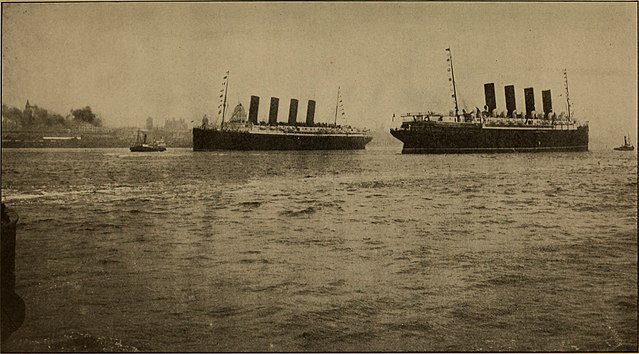Olympic-class ocean liner
The Olympic-class ocean liners were a trio of British ocean liners built by the Harland & Wolff shipyard for the White Star Line during the early 20th century. They were Olympic (1911), Titanic (1912) and Britannic (1914). All three were designed to be the largest and most luxurious passenger ships at that time, designed to give White Star an advantage in the transatlantic passenger trade.
Belfast, 6 March 1912: Titanic (right) moved out of the drydock to allow Olympic to replace a damaged propeller blade
Cunard's ocean liners Lusitania and Mauretania, photographed in 1911. These ships were the largest, most luxurious and fastest ocean liners of the time. The White Star Line decided to overtake them by ordering the construction of the ships of the Olympic class
Titanic and Olympic under construction in Belfast, ca 1910
The Titanic prior to launching, May 31, 1911
An ocean liner is a type of passenger ship primarily used for transportation across seas or oceans. Ocean liners may also carry cargo or mail, and may sometimes be used for other purposes. Only one ocean liner remains in service today.
As of 2024[update], RMS Queen Mary 2 is the only ocean liner still in service
RMS Lusitania arriving in New York in 1907. As the primary means of trans-oceanic voyages for over a century, ocean liners were essential to the transportation needs of national governments, business firms, and the general public.
In 1838, Sirius was the first ship to cross the Atlantic using continuous steam power.
The first voyage of SS Great Western (1838)





![As of 2024[update], RMS Queen Mary 2 is the only ocean liner still in service](https://upload.wikimedia.org/wikipedia/commons/thumb/b/b3/Queen_Mary_2_Boston_July_2015_01_%28cropped%29.jpg/640px-Queen_Mary_2_Boston_July_2015_01_%28cropped%29.jpg)


